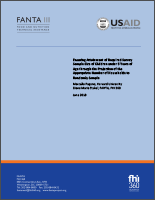
Although mid-upper arm circumference (MUAC) is commonly used to determine the nutritional status of adolescents and adults, there are no global standards to classify acute malnutrition among adolescents and adults using MUAC. As a result, different countries and programs use different MUAC cutoffs to determine eligibility for program services among these population groups. To address this gap, FANTA initiated a two-phase research project with Tufts University to build the evidence base for the use of standardized MUAC cutoffs as indicators of undernutrition among adolescents and adults, including pregnant women.
The first phase was a systematic review of the existing evidence on the use of MUAC as an indicator or predictor of nutrition- and health-related outcomes. Despite significant associations between low MUAC (as defined by various cutoffs) and several adverse health outcomes—particularly among pregnant women—across studies there was insufficient evidence to draw firm conclusions. There were also too few diagnostic tests carried out across the studies to be able to recommend an optimum MUAC cutoff for any particular health outcome at the time of the review.
The second phase consisted of two sets of secondary data analyses, each of several large datasets, to explore the MUAC thresholds for predicting adverse outcomes associated with poor nutritional status; the first set of analyses was for pregnant women and the second for the general adult population.
The first analysis found that it is difficult to recommend a single cutoff to identify pregnant women with undernutrition that would be suitable across settings. The report recommended that countries and programs conduct a cost-benefit analysis to weigh the benefit of treatment against the benefit of a negative outcome averted before adopting a specific MUAC cutoff for pregnant women.
In the general adult population, however, the analysis found that MUAC cutoffs in the range of ≤23.0 cm to ≤25.5 cm could potentially serve as appropriate indicators for low BMI. Based on this finding, the study’s authors proposed that a MUAC of ≤24.0 cm meets the criteria for optimizing sensitivity and specificity across various sub-populations when assessed against low BMI. The authors also noted that validation studies are needed to determine whether the proposed MUAC cutoff can be efficiently and effectively used as a screening tool for adult undernutrition.
If future studies find MUAC to be a valid and reliable nutrition screening tool, its use in communities and clinics will reduce the amount of time and technical skill required for nutrition screening, resulting in a greater number of individuals who would benefit from further nutrition assessment and intervention.


